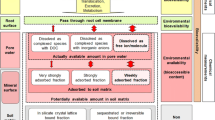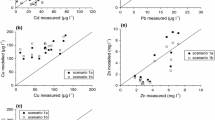Abstract
Transfer functions describing the coprecipitation of various trace elements (TE; As, Cd, Co, Cu, Cr, Mo, Ni, Pb, Zn), precipitating with iron(oxihydr)oxides from an aqueous solution, were developed and implemented in the computer model ‘Seeper’. ‘Seeper’ was developed to predict the progression of the concentrations of inorganic pollutants in unsaturated soils underneath contaminated areas and to evaluate the prospective contamination of the groundwater. Transfer functions provide a straight and simple relation between the coprecipitation of TE and easy to obtain standard soil parameters, without excessive repercussions on the usability and computation time of the model. Laboratory experiments were conducted to quantify coprecipitation in solutions with pH values ranging from 5 to 12 and containing various iron and TE concentrations. For the examined TE, the transfer functions describe the coprecipitated fraction as a function of the pH value and the concentration ratio between precipitated iron and a TE. The transfer functions yielded a good prediction of cadmium, cobalt, copper, molybdenum, nickel, and zinc (R 2 from 0.73 to 0.83). As for arsenic, chromium, and lead the correlation was not as good albeit a significant influence of precipitating iron on the mobility of these elements was observed and represented in the corresponding transfer functions.



Similar content being viewed by others
References
Appelo CAJ, Postma D (1994) Geochemistry, groundwater and pollution. Balkema, Rotterdam, 536 p
Bartlett RJ, James BR (1993) Redox chemistry of soils. In: Spark DL (ed) Advances in agronomy, vol 50. Academic, San Diego, pp 151–208
Becker V, Schulz HD, Hamer K (2007) Reaktiver Stofftransport für die Sickerwasserprognose—Seeper, ein Modell für die Praxis. Grundwasser 12(4):282–291
Benjamin MM, Leckie JO (1981) Multiple-site adsorption of Cd, Cu, Zn and Pb on amorphous iron oxyhydroxide. J Colloid Interface Sci 79:209–221
Bruno J, Duro L, de Pablo J, Casas I, Ayora C, Delgado J, Gimeno MJ, Peña J, Linklater C, Pérez del Villar L, Gómez P (1998) Estimation of the concentrations of trace metals in natural systems: the application of codissolution and coprecipitation approaches to El Berrocal (Spain) and Poços de Caldas (Brazil). Chem Geol 151:277–291
Ciardelli MC, Xu H, Sahai N (2007) Role of Fe(II), phosphate, silicate, sulfate, and carbonate in arsenic uptake by coprecipitation in synthetic and natural groundwater. Water Res 42:615–624
Contin M, Mondini C, Leita L, De Nobili M (2007) Enhanced soil toxic metal fixation in iron (hydr)oxides by redox cycles. Geoderma 140:164–175
Crawford RJ, Harding IH, Mainwaring DE (1993) Adsorption and coprecipitation of single heavy metal ions onto the hydrated oxides of iron and chromium. Langmuir 9:3050–3056
Crawford RJ, Harding IH, Mainwaring DE (1996) The zeta potential of iron and chromium hydrous oxides during adsorption and coprecipitation of aqueous heavy metals. J Colloid Interface Sci 181:561–570
Federal Bulletin (1998) Federal Soil Protection Act—BBodSchG: act on protection against harmful changes to soil and on rehabilitation of contaminated sites. Federal Law Gazette I, 502p. Available at: http://www.umweltbundesamt.de/altlast/web1/berichte/pdf/bbodschg.pdf
Federal Bulletin (1999) Federal Soil Protection and Contaminated Site Ordinance—BBodSchV. BGBl I, 1554 p. Available at: http://www.umweltbundesamt.de/altlast/web1/berichte/pdf/bbodschv-engl.pdf
Ford RG, Bertsch PM, Farley KJ (1997) Changes in transition and heavy metal partitioning during hydrous iron oxide aging. Environ Sci Technol 31:2028–2033
Gitari WM, Petrik LF, Etchebers O, Key DL, Okujeni C (2008) Utilization of fly ash for treatment of coal mines wastewater: solubility controls on major inorganic contaminants. Fuel 87(12):2450–2462
Hiraide M, Chen ZS, Kawaguchi H (1997) Comparison of carrier elements for coprecipitation and graphite-furnace atomic absorption spectrometry. Mikrochim Acta 127:119–123
Jia Y, Demopoulos GP (2008) Coprecipitation of arsenate with iron(III) in aqueous sulfate media: effect of time, lime as base and co-ions on arsenic retention. Water Res 42:661–668
Karthikeyan KG, Elliott HA (1999) Surface complexation modeling of copper sorption by hydrous oxides of iron and aluminum. J Colloid Interface Sci 220:88–95
Karthikeyan KG, Elliott HA, Chorover J (1999) Role of surface precipitation in copper sorption by the hydrous oxides of iron and aluminum. J Colloid Interface Sci 209:72–78
Kumpiene J, Lagerkvist A, Maurice C (2008) Stabilization of As, Cr, Cu, Pb and Zn in soil using amendments—a review. Waste Manage 28:215–225
Lützenkirchen J, Ph Behra (1996) On the surface precipitation model for cation sorption at the (hydr)oxide water interface. Aqua Geochem 1(4):375–397
Nickson RT, McArthur JM, Ravenscroft P, Burgess WG, Ahmed KM (2000) Mechanism of arsenic release to groundwater, Bangladesh and West Bengal. Appl Geochem 15:403–413
Oberacker FE, Eberle SH (2002) BMBF-research-focus ‘percolation water prognosis’ concept and current activities. J Soils Sediments 2(1):24–28
Schulz HD, Reardon EJ (1983) A combined mixing cell/analytical model to describe two-dimensional reactive solute transport for unidirectional groundwater flow. Water Resour Res 19:493–502
Stipp SLS, Hansen M, Kristensen R, Hochella MF Jr, Bennedsen L, Dideriksen K, Balic-Zunic T, Léonard D, Mathieu H-J (2002) Behaviour of Fe-oxides relevant to contaminant uptake in the environment. Chem Geol 190:321–337
Utermann J, Meyenburg G, Altfelder S, Gäbler H-E, Duijnisfeld WHM, Bahr A, Streck T (Utermann et al. 2005) Entwicklung eines Verfahrens zur Quantifizierung von Stoffkonzentrationen im Sickerwasser auf der Grundlage chemischer und physikalischer Pedotransferfunktionen. Endbericht. Available at: http://www.bgr.bund.de/nn_461722/DE/Themen/Boden/Projekte/Bodeneigenschaften/Modellgestuetzte__Sickerwasserprognose__fuer__anorganische__Spurenstoffe/Modell.html
Xu Y, Schwartz FW, Traina SJ (1994) Sorption of Zn2+ and Cd2+ on hydroxyapatite surfaces. Environ Sci Technol 28:1472–1480
Xu Y, Axe L, Boonfueng T, Tyson TA, Trivedi P, Pandya K (2007) Ni(II) complexation to amorphous hydrous ferric oxide: an X-ray absorption spectroscopy study. J Colloid Interface Sci 314:10–17
Author information
Authors and Affiliations
Corresponding author
Rights and permissions
About this article
Cite this article
Becker, V., Lager, T. & Schulz, H.D. Transfer functions simulating the coprecipitation of trace elements in unsaturated soils. Environ Geol 58, 1601–1609 (2009). https://doi.org/10.1007/s00254-008-1666-5
Received:
Accepted:
Published:
Issue Date:
DOI: https://doi.org/10.1007/s00254-008-1666-5




